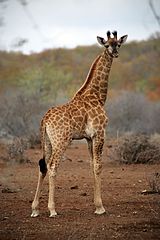
The giraffe is a large African hoofed mammal belonging to the genus Giraffa. It is the tallest living terrestrial animal and the largest ruminant on Earth. Traditionally, giraffes have been thought of as one species, Giraffa camelopardalis, with nine subspecies. Most recently, researchers proposed dividing them into up to eight extant species due to new research into their mitochondrial and nuclear DNA, and individual species can be distinguished by their fur coat patterns. Seven other extinct species of Giraffa are known from the fossil record.

The Giraffidae are a family of ruminant artiodactyl mammals that share a common ancestor with deer and bovids. This family, once a diverse group spread throughout Eurasia and Africa, presently comprises only two extant genera, the giraffe and the okapi. Both are confined to sub-Saharan Africa: the giraffe to the open savannas, and the okapi to the dense rainforest of the Congo. The two genera look very different on first sight, but share a number of common features, including a long, dark-coloured tongue, lobed canine teeth, and horns covered in skin, called ossicones.
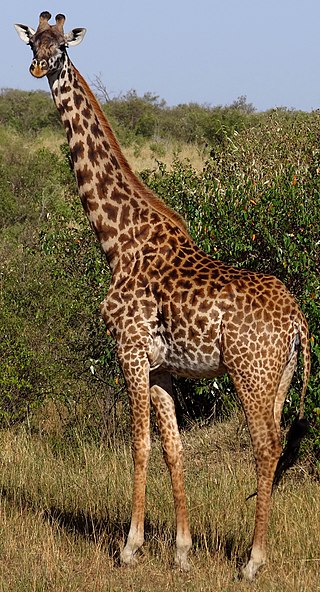
The Masai giraffe, also spelled Maasai giraffe, and sometimes called the Kilimanjaro giraffe, is a species or subspecies of giraffe. It is native to East Africa. The Masai giraffe can be found in central and southern Kenya and in Tanzania. It has distinctive jagged, irregular leaf-like blotches that extend from the hooves to its head. The Masai giraffe is currently the national animal of Tanzania.

The northern giraffe, also known as three-horned giraffe, is the type species of giraffe, G. camelopardalis, and is native to North Africa, although alternative taxonomic hypotheses have proposed the northern giraffe as a separate species.

Burchell's zebra is a southern subspecies of the plains zebra. It is named after the British explorer and naturalist William John Burchell. Common names include bontequagga, Damaraland zebra, and Zululand zebra. Burchell's zebra is the only subspecies of zebra which may be legally farmed for human consumption.
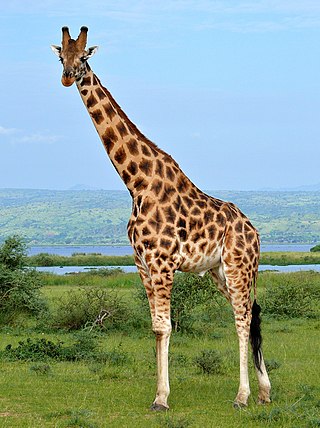
Rothschild's giraffe is a subspecies of the Northern giraffe. It is one of the most endangered distinct populations of giraffe, with 1,399 mature individuals estimated in the wild in 2018.

The wildlife of South Africa consists of the flora and fauna of this country in Southern Africa. The country has a range of different habitat types and an ecologically rich and diverse wildlife, vascular plants being particularly abundant, many of them endemic to the country. There are few forested areas, much savanna grassland, semi-arid Karoo vegetation and the fynbos of the Cape Floristic Region. Famed for its national parks and big game, 297 species of mammal have been recorded in South Africa, as well as 849 species of bird and over 20,000 species of vascular plants.

The buffy pipit is a species of bird in the Motacillidae family. It is found in plains and open countryside in southern and eastern Africa. The IUCN has assessed its conservation status as being of least concern.
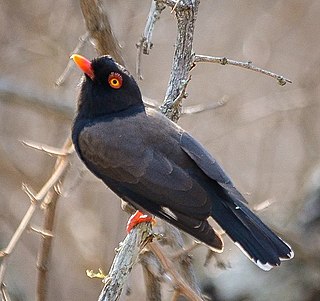
Retz's helmetshrike is a species of bird in the helmetshrike family Vangidae, formerly usually included in the Malaconotidae.

The Peters's epauletted fruit bat is a species of megabat in the family Pteropodidae. It is found in Angola, Botswana, Democratic Republic of the Congo, Eswatini, Malawi, Mozambique, Namibia, Tanzania, Zambia, and Zimbabwe. Its natural habitat is in riverine or evergreen forest, or moist woodland, where there are fruit-bearing trees.

The Cape grass lizard, also known as the Cape snake lizard or the highland grass lizard, is a species of lizard in the genus Chamaesaura. It widely found in southern Africa, inhabiting grasslands. In one of the countries it lives in, Eswatini, it is listed as a Near Threatened species.
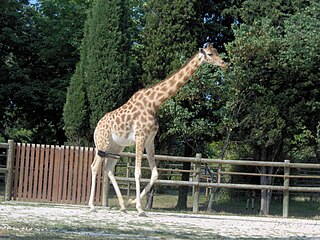
The Kordofan giraffe is a species or subspecies of giraffe found in northern Cameroon, southern Chad, the Central African Republic, and possibly western Sudan. Historically some confusion has existed over the exact range limit of this subspecies compared to the West African giraffe, with populations in e.g. northern Cameroon formerly assigned to the latter. Genetic work has also revealed that all "West African giraffe" in European zoos are in fact Kordofan giraffe. It has been suggested that the Nigerian giraffe's ancestor dispersed from East to North Africa during the Quaternary period and thereafter migrated to its current Sahel distribution in West Africa in response to the development of the Sahara desert. Compared to most other subspecies, the Kordofan giraffe is relatively small at 3.8 to 4.7 meters, with more irregular spots on the inner legs. Its English name is a reference to Kordofan in Sudan. There are around 2,300 individuals living in the wild.
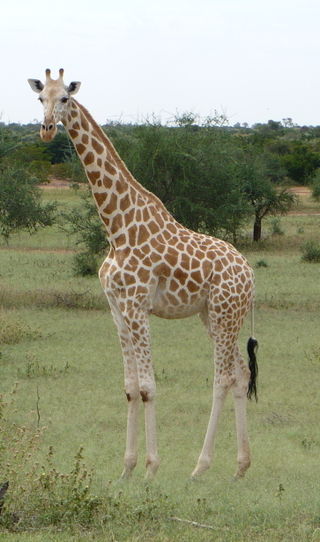
The West African giraffe, also known as the Niger giraffe is a species or subspecies of the giraffe distinguished by its light colored spots. Its last self-sustaining herd is in southwest Niger, supported by a series of refuges in Dosso Region and the tourist center at Kouré, some 80km southeast of Niamey.

Thornicroft's giraffe, also known as the Rhodesian giraffe or Luangwa giraffe, is a subspecies of giraffe. It is sometimes considered a species in its own right or a subspecies of the Masai giraffe. It is geographically isolated, occurring only in Zambia’s South Luangwa Valley. An estimated 550 live in the wild, with no captive populations. Its lifespan is 22 years for males and 28 years for females. The ecotype was originally named after Harry Scott Thornicroft, a commissioner in what was then North-Eastern Rhodesia and later Northern Rhodesia.
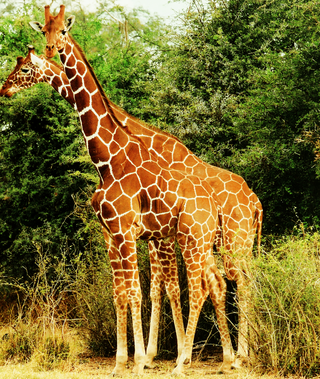
The reticulated giraffe is a species/subspecies of giraffe native to the Horn of Africa. It is differentiated from other types of giraffe by its coat, which consists of large, polygonal, block-like spots, which extend onto the lower legs, tail and face. These prominent liver-red spots also show much less white between them, when compared to other giraffe species. While the reticulated giraffe may yet still be found in parts of its historic range, such as areas of Somalia and Ethiopia, its population stronghold is primarily within Kenya. There are approximately 8,500 individuals living in the wild.

The Southeast African cheetah is the nominate cheetah subspecies native to East and Southern Africa. The Southern African cheetah lives mainly in the lowland areas and deserts of the Kalahari, the savannahs of Okavango Delta, and the grasslands of the Transvaal region in South Africa. In Namibia, cheetahs are mostly found in farmlands. In India, four cheetahs of the subspecies are living in Kuno National Park in Madhya Pradesh after having been introduced there.
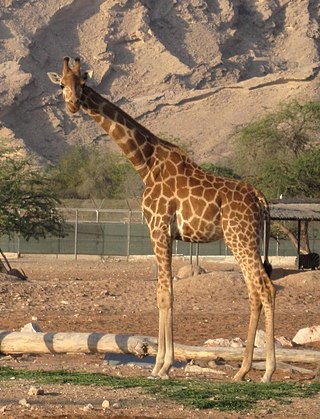
The Nubian giraffe, also known as Baringo giraffe or Ugandan giraffe, is the nominate subspecies or species of giraffe. It is found in Ethiopia, Kenya, Uganda, South Sudan and Sudan. It is currently extinct in the wild of the Democratic Republic of Congo, Egypt and Eritrea. The Nubian giraffe used to be widespread in northeast Africa. The subspecies was listed as Critically Endangered by the IUCN in 2018 for the first time due to a 95% decline in the past three decades.

The Angolan giraffe, also known as the Namibian giraffe or smokey giraffe, is a species or subspecies of giraffe that is found in northern Namibia, south-western Zambia, Botswana, western Zimbabwe and since mid-2023 again in Angola.

The southern giraffe, also known as two-horned giraffe, is a species of giraffe native to Southern Africa. However, the IUCN currently recognizes only one species of giraffe with nine subspecies.





